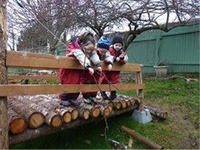Nature and Kindness Connection: Part 1

Have you played outside today?
The following is part one of two blogs that explore the connection between nature and kindness through the stories of those who care for young children.
We intuitively accept the benefits of a daily dose of nature – and for a great list of these benefits check out Morgan Yates’ recent blog. Personally, as a staunch supporter of scaffolding positive experiences for children that support their social and emotional development, I’m curious if spending significant time outdoors will foster Heart-Mind well-being.
With outdoor preschools and kindergartens gaining popularity and more frequent professional development opportunities that promote natural learning environments, this field of study is emerging and looks promising! And while the evidence of a direct connection between nature and kindness has yet to be published, I decided to satisfy my curiosity, by gathering stories from people who spend time with children and observe their behaviours in the great outdoors. I visited with a group of Early Childhood Care and Education students from North Island College and then with the Sincerity Outdoor Playgroup (read more about that experience in Part 2).
Early Childhood Care and Education students are immersed in child development theory and spend countless hours observing and recording children’s behaviours within a variety of childcare settings. Two of the students, Vicky and Daylin, dug out a previous assignment from one of their practicum experiences – that had them recording evidence of social development. Along with photographs, the students documented events and reflected on the children’s learning and growth.

Vicky told me about a “walking field trip” with a group of 3-5 year olds. During this experience, she made the observation that when indoors the children are less concerned for keeping the group together given the physical structures of a room such as walls and other enforced boundaries. On the walking field trip, however, it became abundantly clear that the openness of the environment heightened their awareness of each other. She recounted the situation:
"As the pre-school group walked, one child, let’s call her Sarah, became “pokey” and was walking slowly, exploring the texture of the chain link fence along the path.
The teacher at the front of the line, stopped and asked, “Where is Sarah?”
The other children became concerned for their friend. “Oh no, she is way back there,” one child observed.
The children all started calling “Sarah, Sarah…. come on!”
Some started walking back along the path to meet her. When Sarah (who had been completely undisturbed about being behind) made it to the place where her friends were waiting for her, she was greeted with hugs. The class enfolded Sarah back into the group before proceeding on the journey together.
As the Early Childhood Care and Education students reflected on their learning and experience, Daylin eloquently shared a significant difference she has noticed between indoor and outdoor play. “Inside there is a limited number of toys and materials so sharing has to happen. Outside with everyone equipped with their own stick or path or thing that interests them, the children move beyond just taking turns and they begin to create a shared experience.”
And creating a shared experience is rich, fertile soil for fostering Heart-Mind Well-being!







Comments
Post new comment